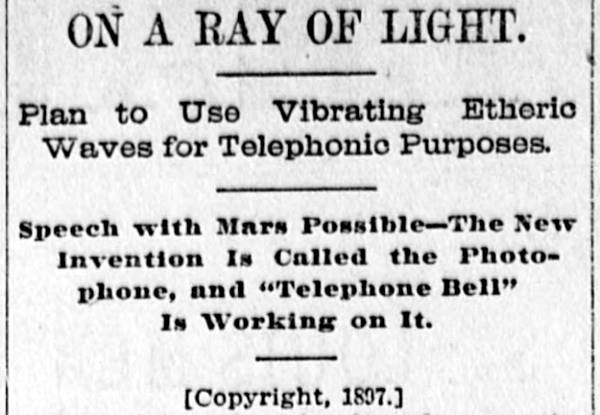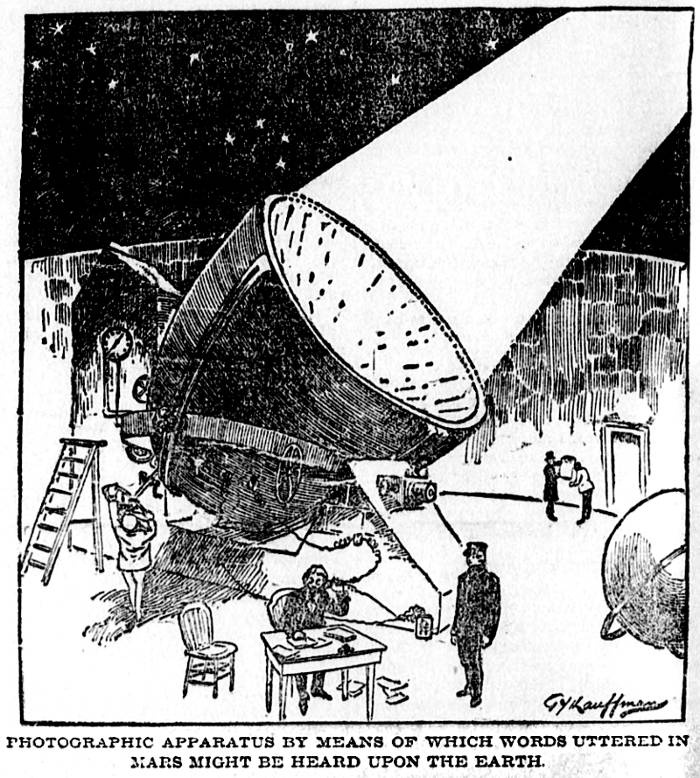To make one’s Voice heard on another planet! To hear the actual words and tones of beings if – they exist and have speech and reason – who are separated from us by millions of miles of empty space! There is nothing, probably, which to the ordinary man would seem more hopelessly impossible than this.
To those who have some knowledge of science the difficulty would seem even more insuperable. Sound is the vibration of air; in a vacuum silence reigns forever. If lifted above the atmosphere, the wildest clangor of bells would be stilled; the heaviest cannon would hurl its bolt without a whisper. How, then, is it conceivable that any sound should ever be carried through tho insterstellar void? How signals might be transmitted to the eye – from Mars, for example, if creatures of sufficient intelligence dwell there – is easily understood. But sound – that is quite mother matter.
Yet science has solved the problem. This does not mean that apparatus of sufficient power and sensitiveness has actually been constructed; the difficulties in the way of an experiment on a scale of such magnitude are too formidable, and the cost would be ruinous. But the means have been found; the impossibility has vanished; the remainder of the problem is mere mechanical detail. Just as the telescope may conceivably be perfected until we can see the minutest objects and look the Martian, if he is there, in the face, so, by the perfecting of this new sort of telephone, we may hear his words, if he has the gift of speech.
For the instrument by which all this is to be accomplished may be very properly be called a telephone – but with a difference. Of course, no wires can ever be stretched from the earth to a flying planet. There is but one possible medlium. It is proposed to telephone along the rays of a shaft of light. It has not only been proposed – it has already been done; though not through interplanetary distances. But if light can carry sound for a single mile, it can carry it to the ends of the universe; and this, perhaps, is really no more wonderful than the fact that through light, by means of the spectroscope, we can analyze the remotest star, and say with certainty that it contains iron and sodium and other well-known metals. Let us not be hasty in setting limits to what science may do by unexpected methods.
Photophone is a more exact name for an instrument which carries words on the wings of light; and so it has been christened by its inventor, Prof. Alexander Graham Bell, who, it is reported, is now busily engaged in perfecting it.
His success in this bold attempt to substitute a bundle of light rays for the electric current and the telephone wire depended upon a peculiar property possessed in any appreciable degree only by the metal selenium, upon the electrical properties of which light has a marked influence. It was found that when this metal, which in many of its chemical and physical properties resembles sulphur and tellurium, is subjected for some time to a heat of 100 degrees and then slowly cooled it assumes a crystalline structure the electrical qualities of which vary remarkably with the intensity of the light to which it is expeosed. Thus a given specimen, the resistance of which in the dark was 1,200 ohms, when exposed to diffused daylight showed a resistance of only 600 ohms.
Now when one talks through an ordinary telephone transmitter, his voice causes a thin sheet-iron diaphragm to vibrate back and forth and this vibration causes a corresponding variation In pressure upon a piece of carbon which forms part of an electric circuit. Thus the conductivity of the circuit Is varied, and what in called an undulating current results, tho variations in strength corresponding exactly to the compressions and rarefactions of the air produced by tho sound waves. At the other end of the line this varying current of electricity is made to pass through tho coil of an electric magnet, causing its magnetism to vary in like manner; and this, setting in vibration a second diaphragm in exact synchronism with that in the transmitter, gives rise to air waves precisely like those produced by the speaker. Thus, although the sound itself is not transmitted over the line, as it is through a speaking tube, we have at the further end an exact reproduction of the original sound waves.
It is clear that any other method of varying an electrical current in correspondence with sound waves would answer the same purpose. It was only necessary to find a proper medium; and in view of the peculiar property of selenium already explained, it occurred to Prof. Bell that if he included a piece of this metal in an electric circuit, and could discover a way of varying the intensity of the light that fell upon it, he could reproduce a series of sound waves which in every particular would echo those at the other end of the line which gave rise to tho variation. Exepriment proved his theory correct; he succeeded, literally, in talking along a ray of light.
His mode of procedure is as follows: Taking as his source of light a pencil of sunlight admitted through a small aperture, or an arc lamp the rays of which were rendered parallel by being passed through a suitable lens, he reflected these rays to the point where the message was to be received by means of a thin diaphragm of mica, which, being silvered, served as a mirror. In order to intensify the effect, a parabolic mirror was set up at the receiving station into which the rays were directed and by which they were focused at a single point. At this point was placed a bit of selenium included in a local telephonic circuit; and the apparatus was complete.
So long as the reflecting diaphragm – which it will be remembered was a plain surface of silver mica – remained quiet, all the rays wore concentrated upon the selenium at the focus of the parabolic mirror, and the electrical current remained steady; but the moment a sound was uttered through the transmitter, the sensitive mica was set in vibration, becoming alternately concave and convex. When convex it dispersed the rays and when concave it concentrated them at a point much nearer than the parabolic mirror. In both case’s the result was the same; the amount of light focused on the selenium was diminished, and this variation was in exact correspondence with the sound waves noting on the mica. The variation in the conductivity of the selenium varied the strength of the electric current passing through it in the same manner, and the sounds were reproduced in the usual way.
The rest is merely a question of the size of the apparatus and its perfect adjustment. If a reflector – or a series of reflectors made to vibrate in unison by means of an electric current – large enough to turn an appreciable beam of light upon the earth could be set up in Mars, and a parabolic receiver of adequate dimensions constructed upon the earth, the speech of the Martians might be heard upon our planet. The theory Is flawless.
Nor does the actual accomplishment of this feat of bringing to the ear of man sounds produced in other worlds seem wholly out of the question, when we consider the astonishing accuracy and sensitiveness of modern scientific instruments. A deviation of less than the One-thousandth of an inch in the polished surface of the object lens of a big telescope would render it worthless. The chemical constitution of a star too remote to be seen by the naked eye is disclosed by the spectroscope; and by means of the balometer – a sort of supersensitive celestial thermometer – its temperature may be registered with surpassing exactness. It is doubtless an astounding project – this of telephoning across the abysses of empty space – but in view of all that has come to pass it is just as well not to be too dogmatic.

